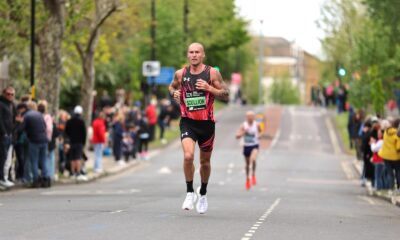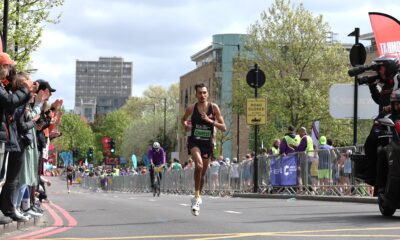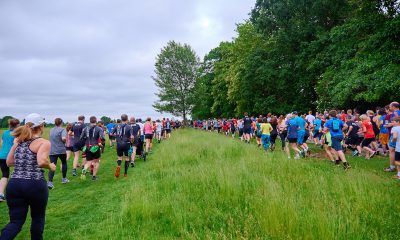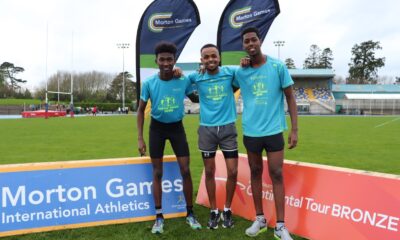
2:36 Marathoner and sociology lecturer Gladys Ganiel reviews a new book by Sean McGoldrick reflecting on 40 fabulous years of one of Europe’s most popular and competitive big city marathons.
Sean McGoldrick’s The Dublin Marathon: Celebrating 40 Years (The O’Brien Press, 2019), is a rare gem of a running book. Boasting a multitude of photographs and reproductions of newspaper clippings, course maps and finishers’ results, it not only looks great, it delivers a fascinating read about the four-decades-long journey of the island’s greatest footrace.
Unlikely beginnings
That journey had an unlikely beginning: While on holidays in New York City, RTÉ Radio producer Louis Hogan was strolling through Central Park while the city’s annual marathon just happened to be taking place. He was intrigued by the spectacle. A few years later his later work with Irish athletics legend Noel Carroll brought a marathon to the streets of Dublin.
Runners take centre stage in the book, from the very fleetest of foot to those who have made up the vast majority of the field each year. Ireland’s pioneering marathon brothers, Olympians Dick and Pat Hooper, feature prominently and rightly so: Dick is a three-time winner of the race (1980, 1985, 1988). There are many photographs and clippings about the brothers, which give readers a sense that they are peeking into the family’s treasured scrapbooks.
Pioneering women’s running in Ireland
The book is also the place where the first women’s winner, Carey May, shares for the first time her experience of harassment during that race (p. 56):
‘An old guy came out of the crowd and pushed and shouted at me that a girl shouldn’t be running a marathon. It was disconcerting because I was very tired and it threw me off my stride. I knew the finish was very close though, so I kept on pushing. I wasn’t going to let an old guy stop me.’
May was competing at a time when female runners were breaking the boundaries of what was thought to be socially acceptable and physically possible. McGoldrick gives those first ladies of Irish running due regard for their role in inspiring countless other women to take up the sport. I was particularly captivated by a photograph of 13 women from Beechmount Harriers, with the accompanying caption (p. 28):
‘In 1978 Mary Butler needed permission from the race director to run a distance of ten miles; by 1982 this group of runners from Beechmount Harriers on the Falls Road in Belfast were ready to tackle the Dublin Marathon.’
As a Belfast woman myself, I can appreciate that those courageous women were not just pushing their bodies to the limits, they also would have been training at the height of the Troubles in an area heavily patrolled by the British Army.
Stories from front to back
Other memorable photographs include a pair of Mick Clohisey, Rio Olympian and first Irish finisher in the 2018 Dublin Marathon (p. 136). In one, he holds his hard-earned trophy. In the other, he is a child in a seat on the back of his mother’s bicycle, waiting for his father to run past during the Dublin Marathon. On the old photograph, someone has stuck a speech bubble [remember when it was popular to put these stickers on printed photographs?] above young Mick’s head. It reads: ‘This beats jogging!’
The book is further enriched by the stories of the so-called ordinary runners who have competed over the years. We are told in the Acknowledgements that Helen Carr from the O’Brien Press ‘commissioned’ these stories, which are interspersed in text boxes throughout the book.
An evolving race
McGoldrick also guides readers through the race’s evolution, exploring the nuts and bolts details of tensions in the early years between the Business Houses Athletics Association organisers and the national governing body for athletics; struggles for sponsorship; and the art of course design. He explains that the race might have gone under in the late 1990s if not for its promotion among American charity runners, then charts its wonderful renaissance since the early 2000s.
Here, we get a charming story about how race director Jim Aughney, Frank Greally of Irish Runner magazine, and Paul Moloney of then-sponsor Adidas were delayed in a London airport after attending the London Marathon expo in 2002 (p. 117-122). Whiling away the hours, they cooked up a scheme to bolster Irish participation in their race: the Dublin Marathon race series. It would feature shorter events during the summer (5 miles, 10 miles, half-marathon), serving as stepping stones to the big day in October.
The race series is still going strong, but participation in the Dublin Marathon itself is greater than perhaps even those three men would have imagined: The marathon had 6,493 finishers after the first race series in 2002; by 2019, there was a sold-out field of 22,500.
Of course, running in Ireland has benefited from a ‘boom’ that took off around 2008. McGoldrick links the boom to the recession, which he argues has taken people’s focus off the relentless pursuit of career and money and freed them up to discover running. He also notes that an earlier Irish ‘running boom’ in the 1980s, the decade of the Dublin Marathon’s birth, was during a period when Ireland struggled economically. As a (professional) sociologist, I would counter that there are more factors at play in the boom than simply economics – the influence of marketing, social media, and more opportunities for women, to name a few. But at the same time, McGoldrick grasps that running provides something that money can’t buy.
This book is itself a reflection of the running boom, in that everyone who loves running, no matter what their pace, can find something in it they can identify with or be inspired by. McGoldrick tells more than the story of a remarkable race – he captures the joy that the Dublin Marathon has brought to countless people.
The Dublin Marathon: Celebrating 40 Years, is available in all good bookshops or online (£16)
Gladys Ganiel lectures in sociology at Queen’s University Belfast and runs for North Belfast Harriers. She completed the 40th Dublin Marathon this October in 2.36.40.
Are you a fan of Fast Running? Then please support us and become a patron. For as little as the price of a monthly magazine you can support Fast Running – and it only takes a minute. Thank you.
















